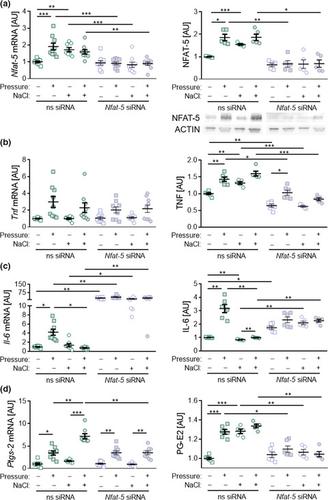当前位置:
X-MOL 学术
›
Immunol. Cell Biol.
›
论文详情
Our official English website, www.x-mol.net, welcomes your
feedback! (Note: you will need to create a separate account there.)
Impact of salt and the osmoprotective transcription factor NFAT5 on macrophages during mechanical strain.
Immunology and Cell Biology ( IF 3.2 ) Pub Date : 2020-09-04 , DOI: 10.1111/imcb.12398 Agnes Schröder 1 , Alexandra Leikam 1 , Paul Käppler 1 , Patrick Neubert 2 , Jonathan Jantsch 2 , Wolfgang Neuhofer 3 , James Deschner 4 , Peter Proff 1 , Christian Kirschneck 1
Immunology and Cell Biology ( IF 3.2 ) Pub Date : 2020-09-04 , DOI: 10.1111/imcb.12398 Agnes Schröder 1 , Alexandra Leikam 1 , Paul Käppler 1 , Patrick Neubert 2 , Jonathan Jantsch 2 , Wolfgang Neuhofer 3 , James Deschner 4 , Peter Proff 1 , Christian Kirschneck 1
Affiliation

|
Myeloid cells regulate bone density in response to increased salt (NaCl) intake via the osmoprotective transcription factor, nuclear factor of activated T cells‐5 (NFAT‐5). Because orthodontic tooth movement (OTM) is a pseudoinflammatory immunological process, we investigated the influence of NaCl and NFAT‐5 on the expression pattern of macrophages in a model of simulated OTM. RAW264.7 macrophages were exposed for 4 h to 2 g cm−2 compressive or 16% tensile or no mechanical strain (control), with or without the addition of 40 mm NaCl. We analyzed the expression of inflammatory genes and proteins [tumor necrosis factor (TNF), interleukin (IL)‐6 and prostaglandin endoperoxide synthase‐2 (Ptgs‐2)/prostaglandin E2 (PG‐E2)] by real‐time‐quantitative PCR and ELISA. To investigate the role of NFAT‐5 in these responses, NFAT‐5 was both constitutively expressed and silenced. Salt and compressive strain, but not tensile strain increased the expression of NFAT‐5 and most tested inflammatory factors in macrophages. NaCl induced the expression of Ptgs‐2/PG‐E2 and TNF, whereas secretion of IL‐6 was inhibited. Similarly, a constitutive expression of NFAT‐5 reduced IL‐6 expression, while increasing Ptgs‐2/PG‐E2 and TNF expression. Silencing of NFAT‐5 upregulated IL‐6 and reduced Ptgs‐2/PG‐E2 and TNF expression. Salt had an impact on the expression profile of macrophages as a reaction to compressive and tensile strain that occur during OTM. This was mediated via NFAT‐5, which surprisingly also seems to play a regulatory role in mechanotransduction of compressive strain. Sodium accumulation in the periodontal ligament caused by dietary salt consumption might propagate local osteoclastogenesis via increased local inflammation and thus OTM velocity, but possibly also entail side effects such as dental root resorptions or periodontal bone loss.
中文翻译:

盐和渗透保护转录因子 NFAT5 在机械应变过程中对巨噬细胞的影响。
骨髓细胞通过渗透保护转录因子、活化 T 细胞核因子 5 (NFAT-5) 调节盐 (NaCl) 摄入量的增加,从而调节骨密度。由于正畸牙齿移动 (OTM) 是一种假性炎症免疫过程,我们在模拟 OTM 模型中研究了 NaCl 和 NFAT-5 对巨噬细胞表达模式的影响。RAW264.7 巨噬细胞暴露于 2 g cm -2压缩或 16% 拉伸或无机械应变(对照)4 小时,添加或不添加 40 m m NaCl。我们分析了炎症基因和蛋白质 [肿瘤坏死因子 (TNF)、白介素 (IL)-6 和前列腺素内过氧化物合酶-2 ( Ptgs-2)/前列腺素 E2 (PG-E2)] 通过实时定量 PCR 和 ELISA。为了研究 NFAT-5 在这些反应中的作用,NFAT-5 被组成型表达和沉默。盐和压缩应变,而不是拉伸应变增加了巨噬细胞中 NFAT-5 和大多数测试炎症因子的表达。NaCl 诱导Ptgs-2 /PG-E2 和 TNF 的表达,而抑制 IL-6 的分泌。同样,NFAT-5 的组成型表达降低了 IL-6 的表达,同时增加了Ptgs-2 /PG-E2 和 TNF 的表达。沉默 NFAT-5 上调 IL-6 并降低Ptgs-2/PG-E2 和 TNF 表达。作为对 OTM 期间发生的压缩和拉伸应变的反应,盐对巨噬细胞的表达谱有影响。这是通过 NFAT-5 介导的,令人惊讶的是,NFAT-5 似乎也在压缩应变的机械转导中发挥调节作用。饮食盐分消耗导致牙周膜中钠的积累可能会通过增加局部炎症和 OTM 速度来促进局部破骨细胞生成,但也可能带来副作用,例如牙根吸收或牙周骨质流失。
更新日期:2020-09-04
中文翻译:

盐和渗透保护转录因子 NFAT5 在机械应变过程中对巨噬细胞的影响。
骨髓细胞通过渗透保护转录因子、活化 T 细胞核因子 5 (NFAT-5) 调节盐 (NaCl) 摄入量的增加,从而调节骨密度。由于正畸牙齿移动 (OTM) 是一种假性炎症免疫过程,我们在模拟 OTM 模型中研究了 NaCl 和 NFAT-5 对巨噬细胞表达模式的影响。RAW264.7 巨噬细胞暴露于 2 g cm -2压缩或 16% 拉伸或无机械应变(对照)4 小时,添加或不添加 40 m m NaCl。我们分析了炎症基因和蛋白质 [肿瘤坏死因子 (TNF)、白介素 (IL)-6 和前列腺素内过氧化物合酶-2 ( Ptgs-2)/前列腺素 E2 (PG-E2)] 通过实时定量 PCR 和 ELISA。为了研究 NFAT-5 在这些反应中的作用,NFAT-5 被组成型表达和沉默。盐和压缩应变,而不是拉伸应变增加了巨噬细胞中 NFAT-5 和大多数测试炎症因子的表达。NaCl 诱导Ptgs-2 /PG-E2 和 TNF 的表达,而抑制 IL-6 的分泌。同样,NFAT-5 的组成型表达降低了 IL-6 的表达,同时增加了Ptgs-2 /PG-E2 和 TNF 的表达。沉默 NFAT-5 上调 IL-6 并降低Ptgs-2/PG-E2 和 TNF 表达。作为对 OTM 期间发生的压缩和拉伸应变的反应,盐对巨噬细胞的表达谱有影响。这是通过 NFAT-5 介导的,令人惊讶的是,NFAT-5 似乎也在压缩应变的机械转导中发挥调节作用。饮食盐分消耗导致牙周膜中钠的积累可能会通过增加局部炎症和 OTM 速度来促进局部破骨细胞生成,但也可能带来副作用,例如牙根吸收或牙周骨质流失。











































 京公网安备 11010802027423号
京公网安备 11010802027423号